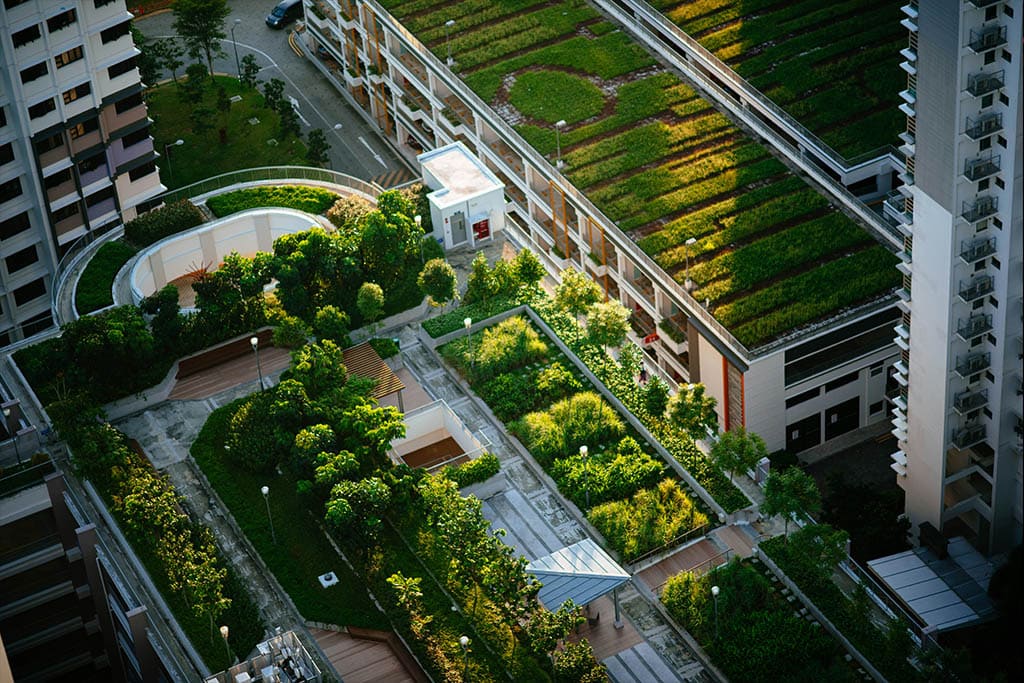SHARE
Thoughts
The fact that sustainability is an essential part of a business strategy has not escaped anyone working in the real asset industry. As a primary contributor to carbon emissions, real assets must rapidly decarbonise, safeguard durable value, and mitigate reputational risks.
- How can real asset investors pivot towards sustainable practices without compromising profitability?
- Is it feasible to retrofit and transform existing assets into models of energy efficiency that meet the stringent demands of modern investors?
- What strategies should real asset investors employ now to future proof their portfolio?
In this article, we delve into these critical questions, presenting a blueprint for decarbonising real estate portfolios while setting the stage for future priorities in the industry.
Setting a Course for Decarbonisation
Best practice in decarbonising a portfolio starts with a thorough understanding of its current environmental impact. This begins with rigorous data collection and analysis to set clear, achievable science-based targets to align with global emission budgets and decarbonisation pathways. We at EVORA believe that a strategic approach anchored in transparency and clear goals is essential. It’s not just about compliance; it’s about setting a course for continual improvement and enabling sustainable growth to future-proof investments.
For example, in our work in developing a global decarbonisation strategy for GCP, we initiated the project by mapping out all relevant activities, data sources, and stakeholders. With all this information in place, we were able to create detailed scenario-based modelling to project various carbon emissions pathways. This comprehensive analysis spanned Scopes 1, 2, and 3, incorporating both operational and embodied carbon, and informed the development of a bespoke Decarbonisation Framework. This framework, aligned with CRREM and SBTi targets, established a global baseline for carbon emissions and outlines strategic interventions and timelines for the client, ensuring our recommendations are perfectly tailored to their growth and decarbonisation strategy.
Hands-on Solutions to Decarbonise Portfolios
So once the strategy is set, how can one go about implementing this in practice?
There is a widespread and agreed upon route to do this, which primarily involves following the energy hierarchy;
Enhancing Energy Efficiency: The journey to sustainability often starts with the fundamentals – upgrading insulation, switching to energy-efficient lighting, and modernising heating and cooling systems. These basic yet powerful alterations significantly reduce energy consumption and the overall carbon footprint of the property.
Smart Technology Integration: Advanced building automation and the integration of smart technologies optimise energy usage and operational efficiency. These technologies provide real-time data that can be used to make immediate adjustments that improve performance and comfort.
Renewable Energy Adoption: Adopting renewable energy sources, such as solar or wind, is pivotal. Installing solar panels or engaging in power purchase agreements (PPAs) for green energy not only supports environmental goals but also stabilises energy costs and reduces dependence on non-renewable sources.
Utilise Cutting-Edge Tools: Take proactive steps towards decarbonising your portfolios by leveraging cutting-edge tools like our SIERA platform’s Net Zero Carbon module. This powerful tool enables our clients to collect, complete, and track carbon data across diverse portfolios, providing valuable insights into current emissions and areas for improvement.
Tenant Engagement and Education: Encouraging tenants to participate in sustainability initiatives through education and engagement strategies ensures that green practices extend beyond the building owner and become a shared responsibility. As a lot of emissions are under tenant control, this is a necessary step to reduce sometimes the majority of a building’s emissions.
Securing Green Certifications: Obtaining certifications like LEED, BREEAM, or GRESB can enhance a building’s marketability to tenants and investors alike, signalling a commitment to sustainable building standards and practices.
These initiatives are not merely responses to regulatory demands, but proactive steps in transitioning to low-carbon operations.
Setting New Priorities for the Future of Real Estate
As we look ahead, the real estate sector must not only continue these efforts but also adapt to emerging challenges and opportunities.
For example, when reflecting on the recent discussions at MIPIM in Cannes, it was made increasingly clear for us that the real estate industry is embracing a significant shift towards sustainable practices. This pivot from a focus on capital appreciation to value creation, influenced by evolving monetary policies, underscores the critical importance of integrating decarbonisation strategies into real estate portfolios. The industry’s movement towards green building initiatives and a robust commitment to sustainability not only aligns with global economic changes but also highlights the necessity and timeliness of adopting such practices.
To align with a future where environmental sustainability becomes a cornerstone of value creation in real estate, future priorities for real assets should include:
Building Resilience: Enhancing properties to withstand climate-related challenges, ensuring that investments are sustainable in the face of changing environmental conditions.
Promoting Circular Economy Principles: Encouraging the use of recycled materials and designs that anticipate future reuse to minimise waste and foster regeneration.
Adapting to Regulatory Changes: Staying up to date with, and leading, the response to global and local regulatory developments in sustainability ensures compliance and strategic advantage.
Leveraging Green Financing: Exploring innovative financial instruments like green bonds to provide the capital necessary to fund sustainable upgrades and tie financial returns to environmental performance.
Let Our Experts Handle the Hard Part
The path to decarbonising real estate investments is complex yet undeniably rewarding. By adopting best practices and focusing on future-oriented sustainability strategies, real asset investors can lead the charge towards a more sustainable and economically resilient future.
With deep expertise and proven strategies, our net zero team is always on hand to help you decarbonise. We help you identify reduction opportunities, track carbon data across portfolios, predict long-term emissions, implement strategies for reducing embodied and operational carbon, and more.
Join us as we transform the landscape of real estate investment, proving that a sustainable approach is not just viable but vital for long-term success.



